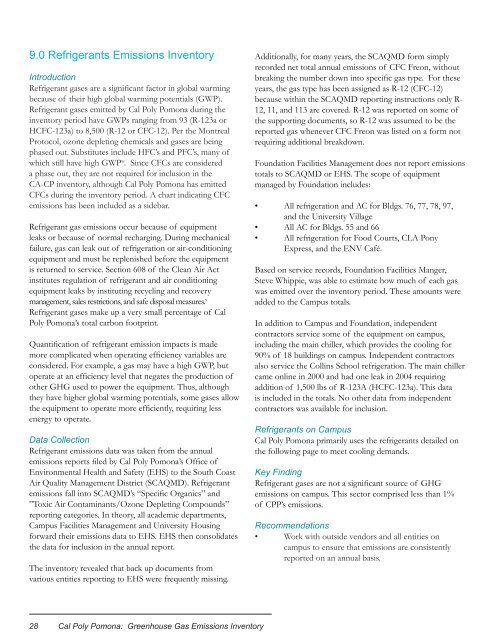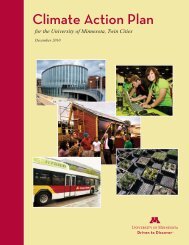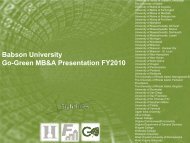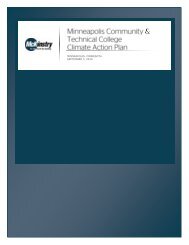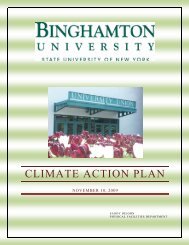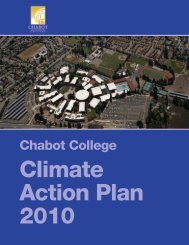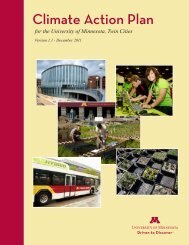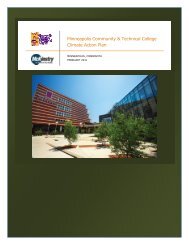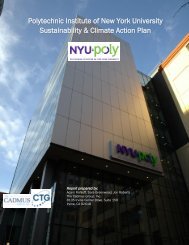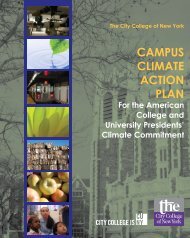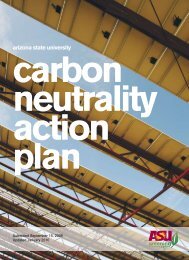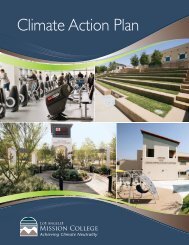Greenhouse Gas Emissions Inventory Report - Cal Poly Pomona
Greenhouse Gas Emissions Inventory Report - Cal Poly Pomona
Greenhouse Gas Emissions Inventory Report - Cal Poly Pomona
Create successful ePaper yourself
Turn your PDF publications into a flip-book with our unique Google optimized e-Paper software.
9.0 Refrigerants <strong>Emissions</strong> <strong>Inventory</strong><br />
Introduction<br />
Refrigerant gases are a significant factor in global warming<br />
because of their high global warming potentials (GWP).<br />
Refrigerant gases emitted by <strong>Cal</strong> <strong>Poly</strong> <strong>Pomona</strong> during the<br />
inventory period have GWPs ranging from 93 (R-123a or<br />
HCFC-123a) to 8,500 (R-12 or CFC-12). Per the Montreal<br />
Protocol, ozone depleting chemicals and gases are being<br />
phased out. Substitutes include HFC’s and PFC’s, many of<br />
which still have high GWP w . Since CFCs are considered<br />
a phase out, they are not required for inclusion in the<br />
CA-CP inventory, although <strong>Cal</strong> <strong>Poly</strong> <strong>Pomona</strong> has emitted<br />
CFCs during the inventory period. A chart indicating CFC<br />
emissions has been included as a sidebar.<br />
Refrigerant gas emissions occur because of equipment<br />
leaks or because of normal recharging. During mechanical<br />
failure, gas can leak out of refrigeration or air-conditioning<br />
equipment and must be replenished before the equipment<br />
is returned to service. Section 608 of the Clean Air Act<br />
institutes regulation of refrigerant and air conditioning<br />
equipment leaks by instituting recycling and recovery<br />
management, sales restrictions, and safe disposal measures. x<br />
Refrigerant gases make up a very small percentage of <strong>Cal</strong><br />
<strong>Poly</strong> <strong>Pomona</strong>’s total carbon footprint.<br />
Quantification of refrigerant emission impacts is made<br />
more complicated when operating efficiency variables are<br />
considered. For example, a gas may have a high GWP, but<br />
operate at an efficiency level that negates the production of<br />
other GHG used to power the equipment. Thus, although<br />
they have higher global warming potentials, some gases allow<br />
the equipment to operate more efficiently, requiring less<br />
energy to operate.<br />
Data Collection<br />
Refrigerant emissions data was taken from the annual<br />
emissions reports filed by <strong>Cal</strong> <strong>Poly</strong> <strong>Pomona</strong>’s Office of<br />
Environmental Health and Safety (EHS) to the South Coast<br />
Air Quality Management District (SCAQMD). Refrigerant<br />
emissions fall into SCAQMD’s “Specific Organics” and<br />
”Toxic Air Contaminants/Ozone Depleting Compounds”<br />
reporting categories. In theory, all academic departments,<br />
Campus Facilities Management and University Housing<br />
forward their emissions data to EHS. EHS then consolidates<br />
the data for inclusion in the annual report.<br />
The inventory revealed that back up documents from<br />
various entities reporting to EHS were frequently missing.<br />
Additionally, for many years, the SCAQMD form simply<br />
recorded net total annual emissions of CFC Freon, without<br />
breaking the number down into specific gas type. For these<br />
years, the gas type has been assigned as R-12 (CFC-12)<br />
because within the SCAQMD reporting instructions only R-<br />
12, 11, and 113 are covered. R-12 was reported on some of<br />
the supporting documents, so R-12 was assumed to be the<br />
reported gas whenever CFC Freon was listed on a form not<br />
requiring additional breakdown.<br />
Foundation Facilities Management does not report emissions<br />
totals to SCAQMD or EHS. The scope of equipment<br />
managed by Foundation includes:<br />
• All refrigeration and AC for Bldgs. 76, 77, 78, 97,<br />
and the University Village<br />
• All AC for Bldgs. 55 and 66<br />
• All refrigeration for Food Courts, CLA Pony<br />
Express, and the ENV Café.<br />
Based on service records, Foundation Facilities Manger,<br />
Steve Whippie, was able to estimate how much of each gas<br />
was emitted over the inventory period. These amounts were<br />
added to the Campus totals.<br />
In addition to Campus and Foundation, independent<br />
contractors service some of the equipment on campus,<br />
including the main chiller, which provides the cooling for<br />
90% of 18 buildings on campus. Independent contractors<br />
also service the Collins School refrigeration. The main chiller<br />
came online in 2000 and had one leak in 2004 requiring<br />
addition of 1,500 lbs of R-123A (HCFC-123a). This data<br />
is included in the totals. No other data from independent<br />
contractors was available for inclusion.<br />
Refrigerants on Campus<br />
<strong>Cal</strong> <strong>Poly</strong> <strong>Pomona</strong> primarily uses the refrigerants detailed on<br />
the following page to meet cooling demands.<br />
Key Finding<br />
Refrigerant gases are not a significant source of GHG<br />
emissions on campus. This sector comprised less than 1%<br />
of CPP’s emissions.<br />
Recommendations<br />
• Work with outside vendors and all entities on<br />
campus to ensure that emissions are consistently<br />
reported on an annual basis.<br />
28 <strong>Cal</strong> <strong>Poly</strong> <strong>Pomona</strong>: <strong>Greenhouse</strong> <strong>Gas</strong> <strong>Emissions</strong> <strong>Inventory</strong>


